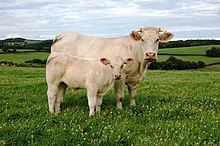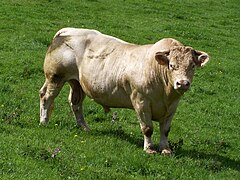|
Charolais cattle
The Charolais (French: [ʃaʁɔlɛ]) or Charolaise ([ʃaʁɔlɛz]) is a French breed of taurine beef cattle. It originates in, and is named for, the Charolais area surrounding Charolles,[4] in the Saône-et-Loire department, in the Bourgogne-Franche-Comté region of eastern France. Charolais are raised for meat; they may be crossed with other breeds, including Angus and Hereford cattle. HistoryThe Charolais is the second-most numerous cattle breed in France after the Holstein Friesian and is the most common beef breed in that country, ahead of the Limousin. At the end of 2014, France had 4.22 million head of Charolais, including 1.56 million cows, down 0.6% from a year earlier.[5] The Charolais is a world breed: it is reported to DAD-IS by 68 countries, of which 37 report population data. The world population is estimated at 730,000. The largest populations are reported from the Czech Republic and Mexico.[6] The breed was introduced to the southern United States from Mexico in 1934.[7] As the cradle of the Charolais cattle,[8] the Charolais-Brionnais Country is applicant for the UNESCO's label as a World Heritage Site to preserve, consolidate and transmit this resource.[9] CharacteristicsIt is among the heaviest of cattle breeds: bulls weigh from 1000 to 1650 kg (2200 to 3600 lb), and cows from 700 to 1200 kg (1500 to 2600 lb). The coat ranges from white to cream-colored; the nose is uniformly pink.[2]: 153 The Charbray, a cross-breed with Brahman cattle, is recognized as a breed in some countries.[10] The Brazilian Chicana is a composite breed with 5/8 Charolais and 3/8 Indu-Brasil.[11] Other derived breeds include Charford and Char-Swiss in the United States.[2]: 153
See alsoReferencesWikimedia Commons has media related to Charolais cattle.
|
||||||||||||||||||||||||||










